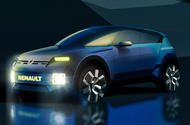Proposed EV will take inspiration from Japanese kei cars
Electric Twingo replacement will break cover later today and go on sale in 2026
Renault has confirmed plans for a new sub-£17,000 electric city car currently known as ‘Legend’, which it claims will offer “best-in-class”efficiency and will serve as a key part of an expanded European line-up of seven EVs.
The new machine will effectively sit underneath the forthcoming 5 and 4, and will serve as a spiritual successor to the Twingo. It is due to be revealed later today (Wednesday) as part of a Capital Markets Day event for Renault Group’s new Ampere spin-off firm. So far, Renault has only referred to the machine as ‘Legend’, which implies it might follow the Megane, Scenic, 5 and 4 models in taking on a retro-inspired nameplate when it reaches production.
So far, Renault Group has only given a few outline details on the Legend model, describing it as a “fit-for-purpose urban vehicle with no compromise”. It claims the machine will offer an impressive efficiency of 6.2mpkWh, and will offer 75 per cent lower CO2 emissions over its lifecycle than the “average European ICE car sold in 2023”.
A previous report in Automotove News Europe suggests that the Legend model could be built at Renault’s factory in Novo Mesto, Slovenia. It would neatly fill the gap left by the Twingo, which is still available in some left-hand-drive markets, but is nearing 10 years old. The Zoe, which is being phased out of production after ten years, will be more directly replaced by the 5.
The Legend will be priced at less than €20,000 (£17,000), which Renault Group claims will cost less than €100 (£87) per month. The firm is due to show the car and reveal further details later today (Wednesday).
The Capital Market Day financial event also serves as a launch for the Ampere firm, a new standalone company within Renault Group. Officially launched on November 1, it will design, engineer manufacture and market EVs in Europe – although models will be sold under the Renault brand. It will have around 35,000 employees.
A key focus for Ampere will be on achieving price parity between EVs and combustion engined vehicles. It will focus on B and C segment models using two existing Renault Group electric platforms. B-segment cars such as the 5, 4 and Legend will be built on the AmpR Small (previously CMF-BEV) architecture, with C-segment cars including the Megane and Scenic using AmpR Medium (CMF-EV).
Ampere claims that has a roadmap to reduce variable costs for the 2nd generation of bespoke C-segment EVs – which the firm describes as “Megane and Scenic successors” – that will arrive by 2027/28 with a focus on a 50 per cent reduction in battery cost per vehicle, a 25 per cent reduction in powertrain and platform costs and a 15 per cent reduction in upper body vehicle costs. It also claims it will refine its operations to reduce manufacturing and logistic costs by half.
The Megane is already on sale, with the Scenic set to join it shortly. The Renault 5 will launch in production form early next year, followed by the more rugged 4 in 2025, and the Legend tipped to arrive in 2026. Ampere then says that two additional cars will arrive as part of its second generation of EVs, growing its line-up of European Renault electric models to seven by 2031. By that point the firm is aiming to sell around a million EVs per year, up from around 300,000 currently.
Further details to follow later today
What we know about plans for the new Renault Legend
Plans for a new entry-level Renault model were made public earlier this year, when company CEO Luca de Meo revealed his ambition to ‘democratise’ EV ownership in Europe. Indications that it will undercut the 5 on price suggest that it could go on sale at around the £20,000 mark.
De Meo referred to the new model as “one of the things that will enable democratisation of EVs that will potentially boost volume”, suggesting that it will help to boost mass electric car ownership in both the UK and mainland Europe.
A huge inspiration for the car, de Meo said, are Japanese-market kei micocars, which are strictly size- and power-regulated. These affordable cars accounted for more than one in three of the 4.2 million new vehicles sold in Japan last year.
“I like very much the idea of translating into European language the concept of kei cars in Japan. So I think that there is some intelligence in that kind of concept, because it’s not only a product issue. It is a product-plus-regulation [issue] to enable efficient and low-impact human mobility.”
The Renault Group already sells the cheapest full-sized electric passenger car in Europe: the Spring. This A-segment crossover, priced from roughly £14,000 in France with local incentives, is smaller than a Ford Fiesta, is capped at 62mph and can cover only 140 miles per charge. It uses an electric motor that makes 44bhp and 92lb ft, and is fed by a 26.8kWh battery.
Speaking about the impact and importance of a car like this, de Meo said: “I’m acting right now as a president of the European [Automobile Manufacturers’] Association. We are fighting against some of the things that we don’t consider right for the industry.
“But on the other side, we’re totally aware that we also have to bring solutions to the problems, [from] air quality to decarbonation. And I think that being able to produce a sub-D-segment, or A-segment car, at a low impact, is probably one of the solutions that the European industry can bring.”
Additional reporting by Felix Page and Will Rimell







